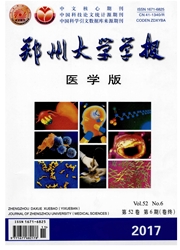

 中文摘要:
中文摘要:
目的:检测重症肌无力(MG)患者胸腺组织中共刺激分子B7-H1的表达。方法:以正常胸腺组织为对照,采用RT-PCR法检测胸腺增生(14例)、胸腺萎缩(5例)和胸腺瘤(6例)组织中B7-H1mRNA的表达,流式细胞仪分析胸腺组织中B7-H1蛋白的表达情况,免疫组化染色方法观察胸腺组织中B7-H1蛋白的分布。结果:不同类型胸腺组织中BH-H1mRNA和蛋白表达差异有统计学意义(FmRNA=5.152,P=0.005;F蛋白=116.049,P〈0.001)。免疫组化染色结果显示,B7-H1蛋白阳性信号主要定位于胸腺组织的皮髓质交界处和髓质胸腺细胞膜上,胸腺增生组织中B7-H1蛋白阳性胸腺细胞数量较多,分布密集,信号强度高。结论:B7-H1mRNA和蛋白的高表达可能与MG胸腺组织异常增生有关。
 英文摘要:
英文摘要:
Aim:To detect the expression of co-stimulatory molecule B7-H1 in thymus tissue of myasthenia gravis(MG) patients.Methods:With normal thymus as control,expression level of B7-H1 mRNA in the thymus tissue from 25 patients with MG was detected by RT-PCR,while tissue distribution and expression level of B7-H1 proteins in different pathological types of MG were detected by immunohistochemical staining and flow cytometry,respectively.Results:The expression of B7-H1 mRNA and protein were significantly different among the 4 groups(FmRNA=5.152,P=0.005;Fprotein=116.049,P0.001).Immunohistochemical staining showed that the B7-H1 protein was mainly located in the membrane of thymus cell in the thymic medulla and the junction between thymic cortex and medulla.Conclusion:The high expression of B7-H1 mRNA and protein may interfere with the thymic dysplasia in MG patients.
 同期刊论文项目
同期刊论文项目
 同项目期刊论文
同项目期刊论文
 期刊信息
期刊信息
